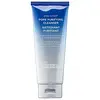What's inside
What's inside
 Key Ingredients
Key Ingredients

 Benefits
Benefits

 Concerns
Concerns

 Ingredients Side-by-side
Ingredients Side-by-side

Water
Skin ConditioningDisodium C12-14 Pareth-3 Sulfosuccinate
CleansingCocamidopropyl Betaine
CleansingSodium Lauryl Sulfoacetate
CleansingPhenoxyethanol
PreservativeSodium Sulfate
Sodium Chloride
MaskingPEG-150 Pentaerythrityl Tetrastearate
EmulsifyingGlycol Stearate
EmollientHydroxypropyl Guar
Emulsion StabilisingPEG-6 Caprylic/Capric Glycerides
EmulsifyingLaureth-10
EmulsifyingEthylhexylglycerin
Skin ConditioningRosmarinus Officinalis Leaf Oil
MaskingCitric Acid
BufferingDisodium EDTA
Glycerin
HumectantStearamide Amp
Melaleuca Alternifolia Leaf Oil
AntioxidantLinalyl Acetate
MaskingSalicylic Acid
MaskingSalix Alba Bark Extract
AstringentGeranium Maculatum Extract
TonicWater, Disodium C12-14 Pareth-3 Sulfosuccinate, Cocamidopropyl Betaine, Sodium Lauryl Sulfoacetate, Phenoxyethanol, Sodium Sulfate, Sodium Chloride, PEG-150 Pentaerythrityl Tetrastearate, Glycol Stearate, Hydroxypropyl Guar, PEG-6 Caprylic/Capric Glycerides, Laureth-10, Ethylhexylglycerin, Rosmarinus Officinalis Leaf Oil, Citric Acid, Disodium EDTA, Glycerin, Stearamide Amp, Melaleuca Alternifolia Leaf Oil, Linalyl Acetate, Salicylic Acid, Salix Alba Bark Extract, Geranium Maculatum Extract
Water
Skin ConditioningSodium Cocoyl Isethionate
CleansingCocamidopropyl Hydroxysultaine
CleansingGlycerin
HumectantPolyglyceryl-3 Methylglucose Distearate
EmulsifyingBetaine
HumectantGlyceryl Distearate
EmollientVitis Vinifera Seed Oil
EmollientSimmondsia Chinensis Seed Oil
EmollientPersea Gratissima Oil
Skin ConditioningCocos Nucifera Oil
MaskingCaprylic/Capric Triglyceride
MaskingXylitylglucoside
HumectantPropanediol
SolventPolyacrylate Crosspolymer-6
Emulsion StabilisingGlyceryl Stearate
EmollientCetearyl Alcohol
EmollientCaprae Lac
Skin ConditioningLactose
HumectantMilk Protein
Skin ConditioningLactic Acid
BufferingTocopherol
AntioxidantMel Extract
MoisturisingRosmarinus Officinalis Leaf Extract
AntimicrobialHelianthus Annuus Extract
EmollientBisabolol
MaskingAloe Barbadensis Leaf Juice
Skin ConditioningSodium Lauroyl Glutamate
Oryza Sativa Bran Extract
Skin ConditioningXylitol
Humectant1,2-Hexanediol
Skin ConditioningAnhydroxylitol
HumectantParfum
MaskingStearic Acid
CleansingDisodium EDTA
Caprylhydroxamic Acid
Xanthan Gum
EmulsifyingT-Butyl Alcohol
PerfumingBenzyl Salicylate
PerfumingWater, Sodium Cocoyl Isethionate, Cocamidopropyl Hydroxysultaine, Glycerin, Polyglyceryl-3 Methylglucose Distearate, Betaine, Glyceryl Distearate, Vitis Vinifera Seed Oil, Simmondsia Chinensis Seed Oil, Persea Gratissima Oil, Cocos Nucifera Oil, Caprylic/Capric Triglyceride, Xylitylglucoside, Propanediol, Polyacrylate Crosspolymer-6, Glyceryl Stearate, Cetearyl Alcohol, Caprae Lac, Lactose, Milk Protein, Lactic Acid, Tocopherol, Mel Extract, Rosmarinus Officinalis Leaf Extract, Helianthus Annuus Extract, Bisabolol, Aloe Barbadensis Leaf Juice, Sodium Lauroyl Glutamate, Oryza Sativa Bran Extract, Xylitol, 1,2-Hexanediol, Anhydroxylitol, Parfum, Stearic Acid, Disodium EDTA, Caprylhydroxamic Acid, Xanthan Gum, T-Butyl Alcohol, Benzyl Salicylate
 Reviews
Reviews

Ingredients Explained
These ingredients are found in both products.
Ingredients higher up in an ingredient list are typically present in a larger amount.
Disodium EDTA plays a role in making products more stable by aiding other preservatives.
It is a chelating agent, meaning it neutralizes metal ions that may be found in a product.
Disodium EDTA is a salt of edetic acid and is found to be safe in cosmetic ingredients.
Learn more about Disodium EDTAGlycerin is already naturally found in your skin. It helps moisturize and protect your skin.
A study from 2016 found glycerin to be more effective as a humectant than AHAs and hyaluronic acid.
As a humectant, it helps the skin stay hydrated by pulling moisture to your skin. The low molecular weight of glycerin allows it to pull moisture into the deeper layers of your skin.
Hydrated skin improves your skin barrier; Your skin barrier helps protect against irritants and bacteria.
Glycerin has also been found to have antimicrobial and antiviral properties. Due to these properties, glycerin is often used in wound and burn treatments.
In cosmetics, glycerin is usually derived from plants such as soybean or palm. However, it can also be sourced from animals, such as tallow or animal fat.
This ingredient is organic, colorless, odorless, and non-toxic.
Glycerin is the name for this ingredient in American English. British English uses Glycerol/Glycerine.
Learn more about GlycerinWater. It's the most common cosmetic ingredient of all. You'll usually see it at the top of ingredient lists, meaning that it makes up the largest part of the product.
So why is it so popular? Water most often acts as a solvent - this means that it helps dissolve other ingredients into the formulation.
You'll also recognize water as that liquid we all need to stay alive. If you see this, drink a glass of water. Stay hydrated!
Learn more about Water